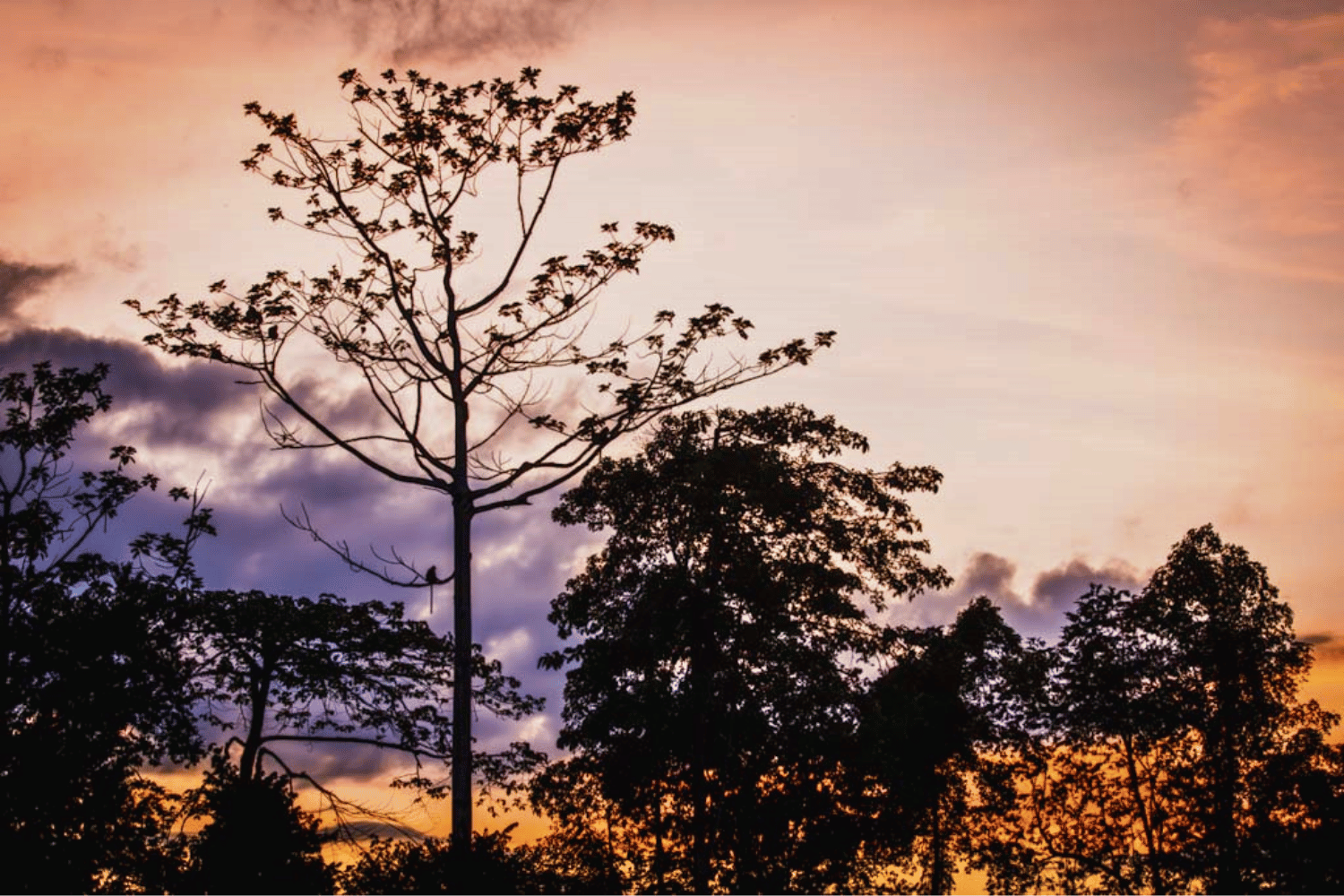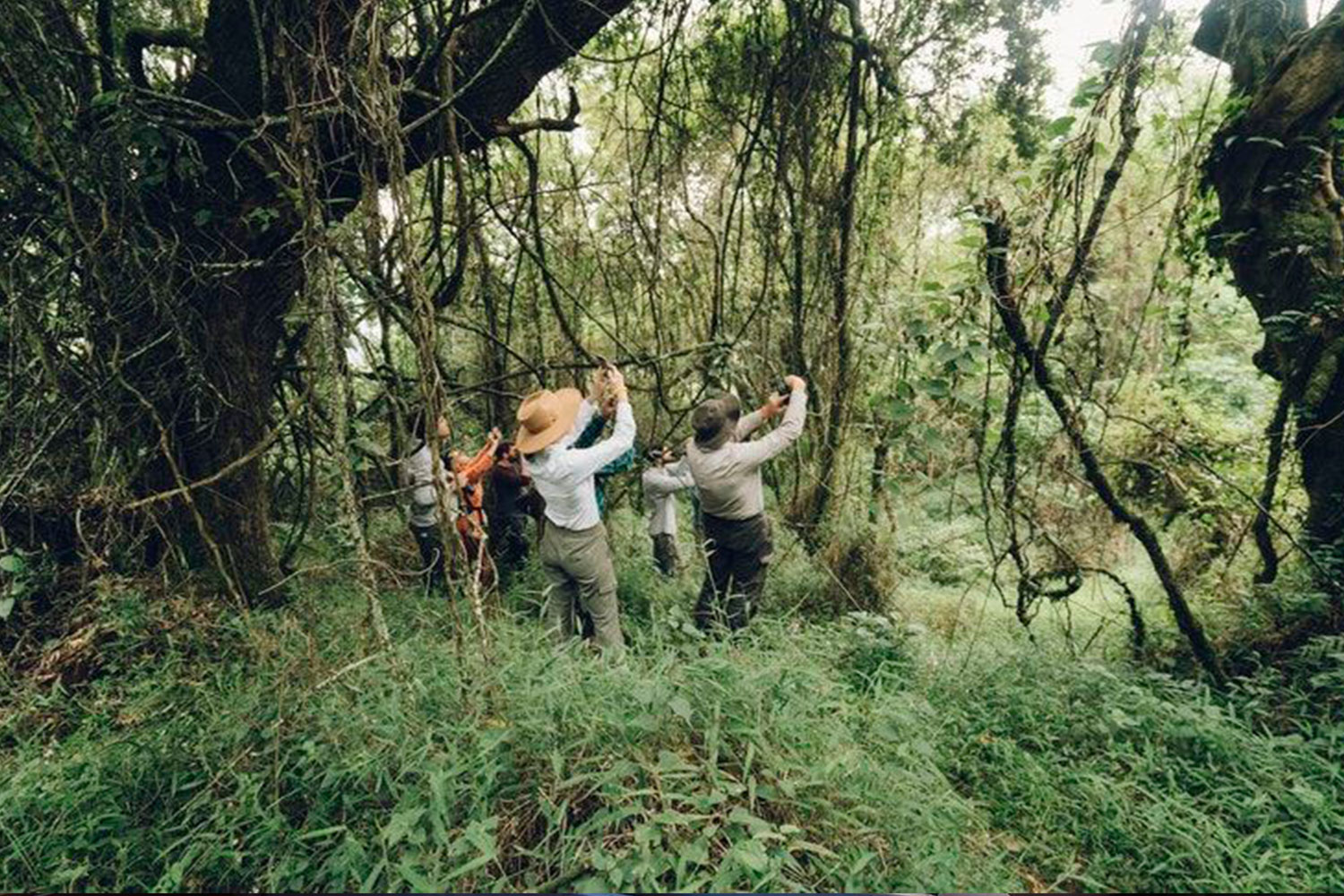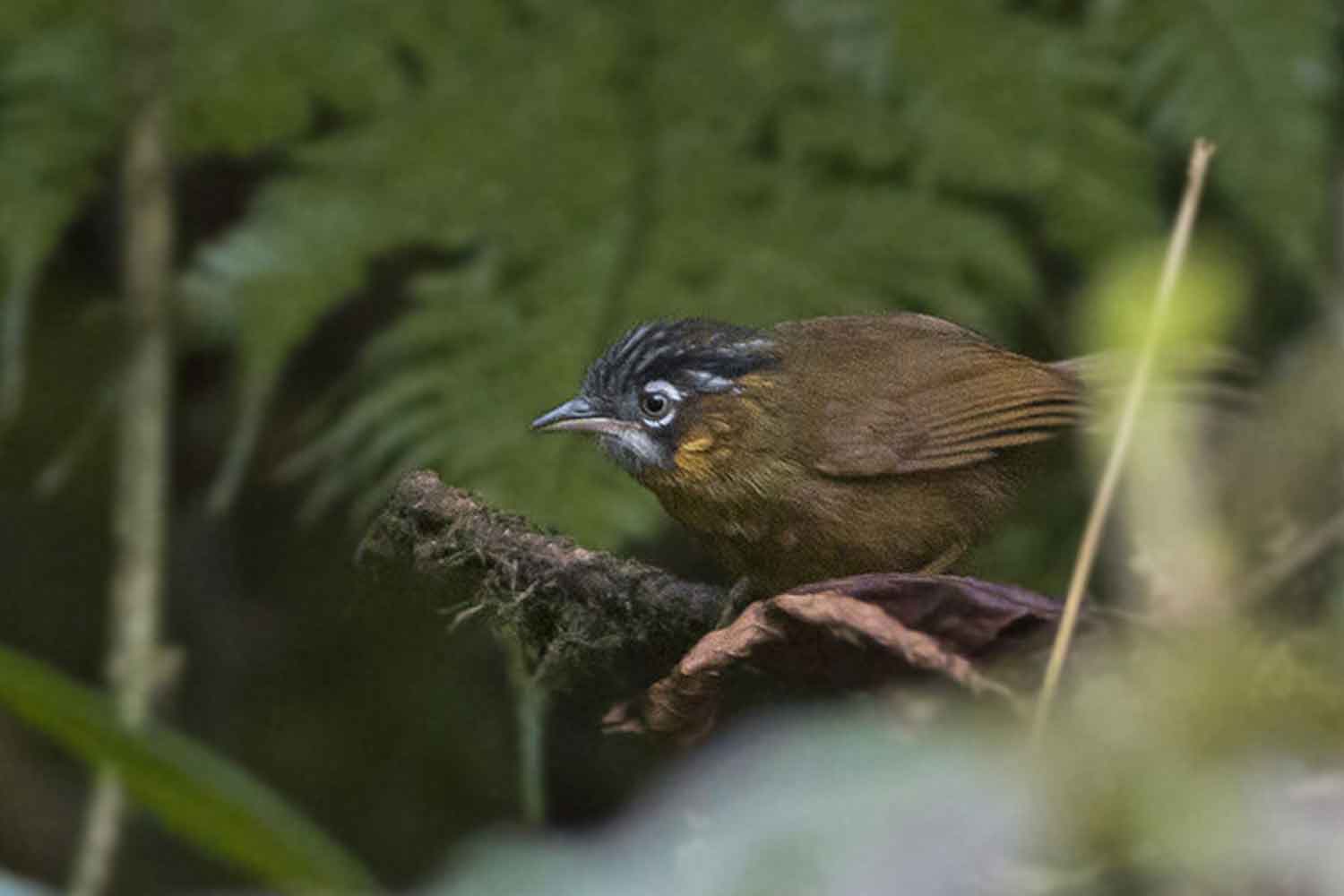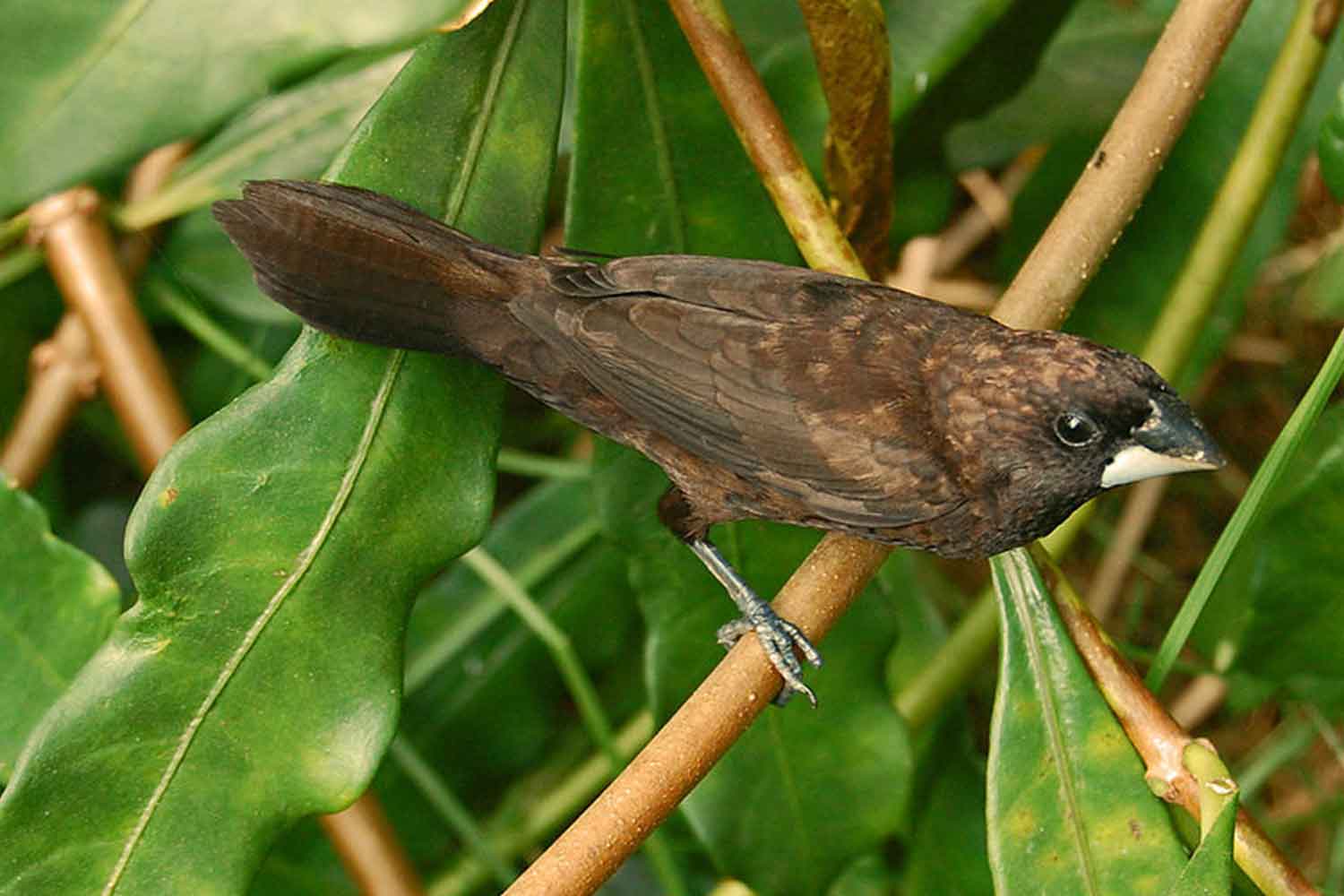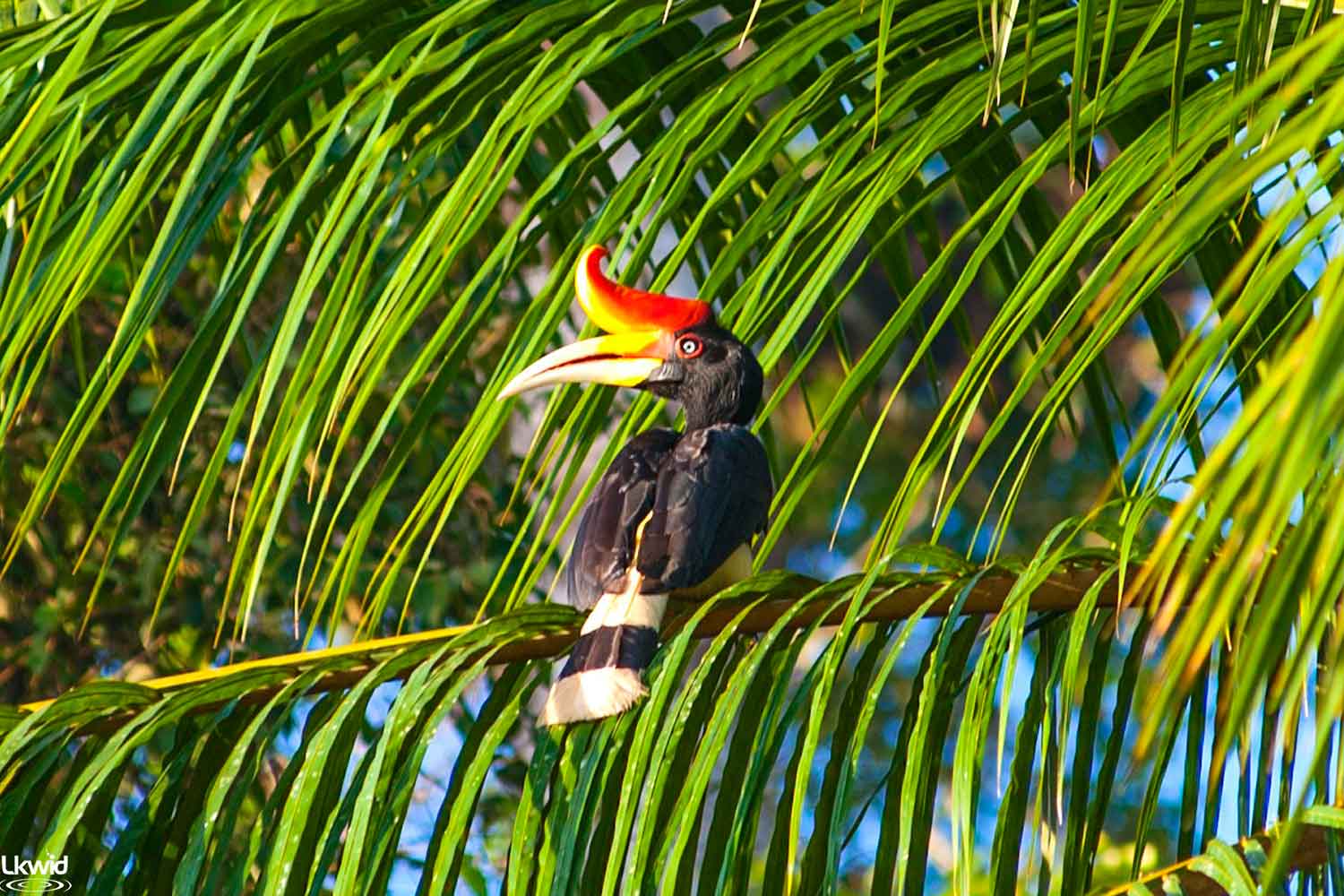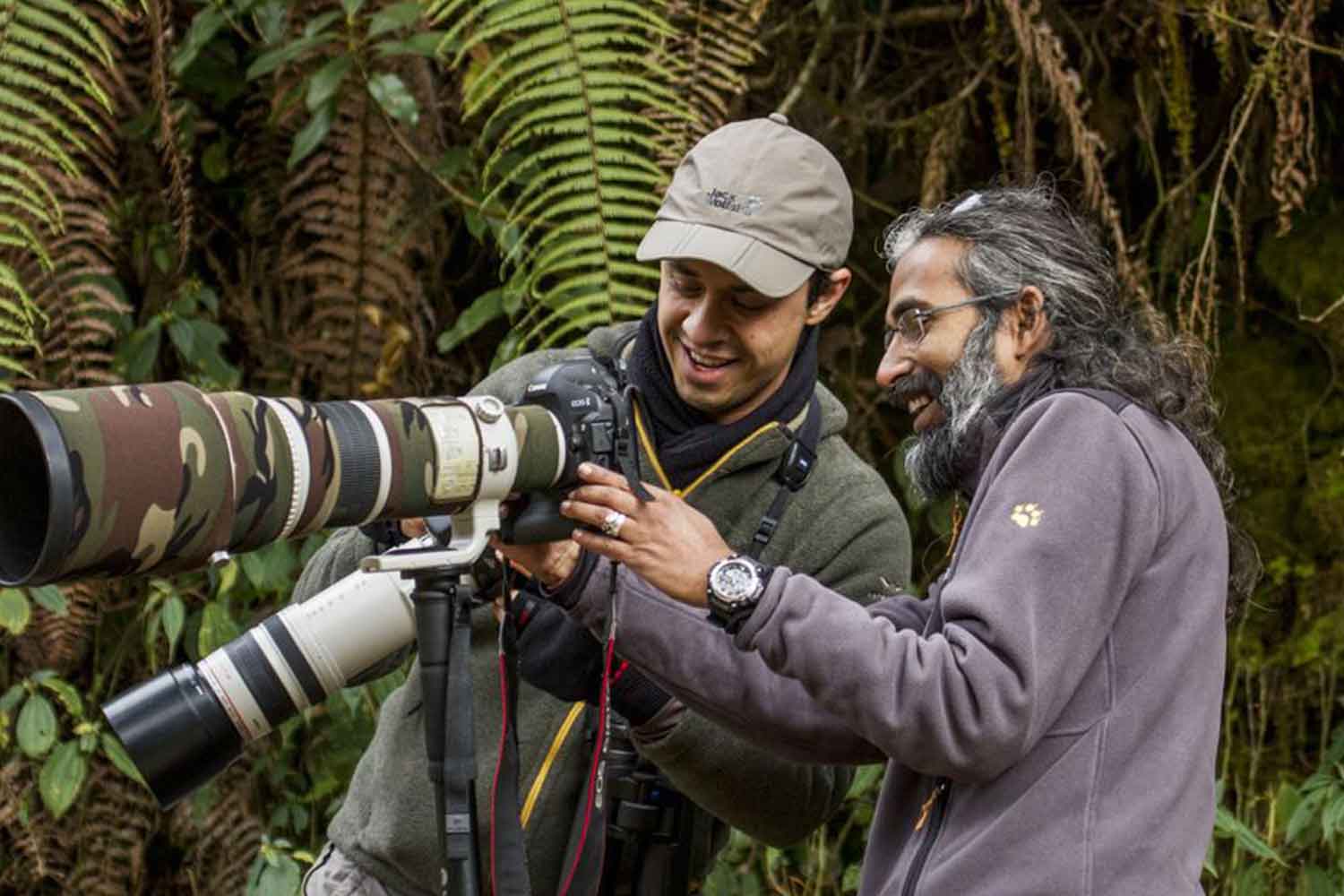Overview
The island of Borneo is a world hotspot for endangered species. Our tour to Sabah on the island of Borneo highlights the critical status of one of the finest primates of this planet, the Orangutan. You will spend time in the ecosystem that supports it, and also look at the threats that are pushing it towards extinction. This tour offers birding, mammal watching, nature, adventure, food, and ecotourism experiences.
You will embark on an extraordinary tour through Borneo's rich rain-forests, teeming with diverse species. You will visit Sabah's major habitats, focusing on its splendid bird life, while also spotting special mammals.
Our nature-centric adventure starts in the majestic Kinabalu National Park (4095m). This is the place to get some endemics of Borneo. The guided walks are delightful at an elevation of 1500+ meters.
You will visit the Sepilok Reserve, the Kinabatangan River, and the captivating Gomantong Caves.
You'll not miss the opportunity to observe Orangutans, Proboscis Monkeys and other primates.
At Tabin, enjoy spotlighting to spot Sunda Leopard Cats and various civets.
Also, we will have a great chance to see the Bornean Gibbon, a critically endangered lesser ape.
A visit to the pristine Danum Valley will further enrich our wildlife encounters.
For birders, Sabah is a renowned birding destination in South-East Asia, offers an extraordinary avifauna that will leave birdwatchers in awe.
You'll love seeing the Bornean Bristlehead and the unique Pittas, like the Blue-headed and Black-crowned types. The lush rainforests are home to a myriad of Broadbills, Trogons, and majestic Rhinoceros Hornbills, along with several other Hornbill species.
The journey takes you to places for millions of swifts in flight, eagles and hawks taking advantage of this abundant food source. The surrounding reserve reveals treasures like the Blue-headed Pitta, Wreathed or Bushy-crested Hornbills, and sometimes, even the Orangutan or the Red-leaf Monkey, makes an appearance.
This comprehensive tour explores the finest habitats, offering opportunities to observe around 200 bird species and targeting 20+ key mammal species as well.
Sabah's captivating wilderness promises an unforgettable wildlife adventure.

Meals: Lunch and Dinner
Accommodation: Hotel Perkasa
Today, you will have arrived at Kota Kinabalu from Kuala Lumpur in the morning. Upon your arrival, undertake a 2/3-hour drive to Kinabalu National Park.
Check in to a comfortable hotel outside the park before heading out for an afternoon birdwatching session with your guide in the vicinity.
It'll be a slow-paced day to acclimatize to the height and the weather.
Of the total bird species recorded, 24 are primarily found on the mountain, and the Bornean spiderhunter stands as a pure endemic species.
Look out for some sought-after endemics that may be found commonly in the area and such as the Mountain Serpent Eagle, Mountain Leaf-warbler, Borneo Treepie, Sunda Laughingthrush.
Kinabalu Park, with four climatic zones, boasts one of the richest collections of biodiversity in the world, housing and protecting over 4,500 species of flora and fauna–including 326 bird species, an estimated of over 100 mammal species, over 110 land snail species, and its biggest attraction, Mount Kinabalu. This includes the breathtaking rafflesia, one of the world's largest flowers, boasting giant red blossoms up to 170 centimeters in diameter. The park's flora includes over 800 orchid species, over 500 fern species, and the world's richest collection of pitcher plants (nepenthes). The avian are rhinoceros hornbill, mountain serpent-eagle, Dulit frogmouth, eyebrowed jungle flycatcher, and pale-faced bulbul. Of the total bird species recorded, 24 are primarily found on the mountain, and the Bornean spiderhunter is a pure endemic species.

Meals: Breakfast, Lunch and Dinner
Accommodation: Hotel Perkasa
We will spend the next two days taking long and easy walks along the road in the park and following some trails from time to time.
In between, we'll find time to head back to the hotel for lunch.
These 2 days will involve exploring the park. With a variety of trails to explore, the opportunities to encounter fascinating species are abundant. This habitat stands in stark contrast to the lowland rainforest you are yet to experience later on the tour, as it consists of a high-altitude forest adorned with moss and lichen, creating a unique home for numerous special species.
While some trails may involve varying elevations and narrow paths, most of our walks will be along the road, offering a pleasant and rewarding exploration of this unique and rich environment.
We will venture into the excellent network of trails that extend into the montane evergreen mossy forest. Within the mixed feeding flocks that roam the woodlands, we'll encounter various common species such as Chestnut-hooded Laughingthrushes, Chestnut-crested Yuhina, Mountain Leaf-warbler, and Yellow-breasted Warbler, as well as White-throated Fantail, Grey-throated Babbler, Black-capped White-eye, Temminck's Sunbird, Ashy and Hair-crested Drongos, Black and Crimson Orioles, and the Bornean Green Magpie.
Among these, you'll also search for some of the more elusive species, including Crimson-headed Partridge, Temminck's Babbler, Black-breasted Fruithunter, Eyebrowed Jungle Flycatcher, Bornean Stubtail, and, of course, Whitehead's Trogon, Spiderhunter, and Broadbill.
The 18 Bornean endemics, including remarkable birds such as Mountain Black Eye, Mountain Blackbird, Bornean Treepie, Kinabalu Serpent Eagle, Red-breasted Wood Partridge, Bornean Mountain Whistler, Orange-headed Thrush, Everett's Thrush, and Eyebrowed Thrush, among others are some species to go for.
The varying altitude and climates on Kinabalu create diverse habitats, ranging from lowland forests to middle-altitude oak, rhododendron, and conifer forests, culminating in alpine meadows, stunted bushes, and bare rock at the summit. The plant species found here have origins in the Himalayas, Australasia, and the Indo-Malayan region.
Kinabalu Park, with four climatic zones, boasts one of the richest collections of biodiversity in the world, housing and protecting over 4,500 species of flora and fauna–including 326 bird species, an estimated of over 100 mammal species, over 110 land snail species, and its biggest attraction, Mount Kinabalu. This includes the breathtaking rafflesia, one of the world's largest flowers, boasting giant red blossoms up to 170 centimeters in diameter. The park's flora includes over 800 orchid species, more than 500 fern species, and the world's richest collection of pitcher plants (nepenthes). The avian species are wreathed hornbill, eyebrowed jungle flycatcher, and pale-faced bulbul.
While numerous mammal species inhabit the mountain, most of them reside high in the trees, making sightings rare. Among these elusive creatures are squirrels, weasels, deer, and shrews. Kinabalu is the home of several endemic species, including the black shrew, Bornean ferret-badger, and Whitehead's Pygmy Squirrel.

Meals: Breakfast, Lunch, Dinner
Accommodation: Borneo Sepilok Rainforest Resort
After breakfast, travel 6 hours to Sepilok and settle into your accommodation.
Sepilok is a primary rainforest reserve. Within the reserve is the Orangutan rehabilitation center and the Sun Bear Rescue Center. The rest of the reserve is the Rainforest Discovery Center. The forest boasts an array of birds and small mammals, including tarsier, langurs, and Orangutans.
Sabah Wildlife Department rehabilitated the Orangutans and then released them back into their natural habitat.
Please note that some of them are semi-wild and more unpredictable than wild orangutans. This is not a zoo and they are free to wander.
In the afternoon, we will go for a walk in the Sepilok Forest Reserve to look for bird species such as Bornean Bristlehead, Black-crowned Pitta, White-crowned Shama, and Broadbills.
We will return to the canopy walkway at dusk to watch the Red Giant Flying Squirrels emerge. They have installed special nest boxes to support these squirrels in their habitat.
For those interested can go for an optional night walk in the forest. This night walk offers an opportunity to encounter the thriving nocturnal wildlife of the area. With luck, you may see a roosting Oriental Dwarf Kingfisher or a Collared Scops Owl. Keep an eye out for the Red Giant Flying Squirrel and various reptiles, amphibians, and other fascinating mammals that inhabit the forest during the night. It's an adventure not to be missed!
Later, we will gather for dinner and receive a briefing about the exciting adventure ahead.

Meals: Breakfast, Lunch and Dinner
Accommodation: Borneo Sepilok Rainforest Resort
Morning birding around the lodge.
After breakfast, you’ll visit the Orangutan Center and Sun Bear rehabilitation area. This is an exciting experience as you see close interaction between primates and humans. You'll see a lot of activity with Pig-tailed and Long-tailed Macaques while Orangutans pick up their share of fruit.
This is the time to take a lot of pictures.
In the afternoon, we will visit the Rainforest Discovery Centre, which grants access to the lowland primary rainforest in Sepilok.
Our priority will be birdwatching and mammal watching.
We will mainly look for birds such as Bornean Bristlehead, Blue-headed Pitta, Rufous-collared Kingfisher, different hornbill species, and other interesting birds.
We will look out for orangutans, squirrels, and tree shrews, which are occasionally spotted in this area. We will look for other wildlife, and we may spot Copper-throated Sunbird, Blue-eared barbet, and Rhinoceros Hornbill.
Returning to the lodge for dinner, those interested can join a night walk to spot nocturnal wildlife. Keep an eye out for creatures like the Colugo or Slow Loris, which may reveal themselves in the spotlight during this enchanting experience.

Meals: Breakfast, Lunch and Dinner
Accommodation: Borneo Nature Lodge
We will start early i.e. 0600 am to get to the world-famous Gomantong caves in 2 hours for edible nest swiftlets and bats.
You will spend an hour walking in the reserve and also explore inside the caves if you wish. You will take your time to enjoy the spectacle provided by these outstanding caverns.
The caves tower to staggering heights of 100 meters or more and are home to literally millions of bats and, seasonally, swiftlets. It is here that every 3-4 months, local tribal people come for a week at a time to gather the nests that are used by the Chinese to make 'bird's nest soup.' How these people reach the heights of these caves on precarious, locally made ropes and bamboo ladders is terrifying and incredible.
While at the main cave, search for wildlife in the rainforest along the entrance road, such as Blue-headed Pitta, Wreathed, or Bushy-crested Hornbill, or even a red-leaf monkey or an Orangutan.
Note: Gomantong Caves may close sometimes due to damage to the boardwalk there.
You will continue for another 3o minutes to the Kinabatangan River.
The mighty Lower-Kinabatangan River sustains one of the world’s richest ecosystems. It is also recognized as Sabah’s first and Malaysia’s largest RAMSAR site. Other than being home to Borneo’s indigenous orangutan and proboscis monkey, the surrounding forest is one of only two known places in the world where 10 species of primates can be found.
This is Malaysia’s second-longest river with a massive length of 560km from its source in Southwest Sabah to its outlet at the Sulu Sea.
In this lush habitat, we will have the chance to observe wild orangutans and target the elusive mammals. The area is also a prime location to encounter troops of Proboscis Monkeys, the endemic primates that feed along the riverside trees.
Kinabatangan birding will be on a boat, making it enjoyable to discover various bird species. Keep an eye out for kingfishers, raptors, and an abundance of hornbills.
Some special bird species to watch for are the Black-and-yellow Broadbill, Changeable Hawk Eagle, hornbill species like Wreathed, Wrinkled, Asian Black, and White-crowned, and the rare Storm's Stork. We will also aim to spot Stork-billed, Collared, and Blue-eared Kingfishers during our birding adventure.
In the evening, an optional night boat ride will be available for those interested. This nocturnal excursion offers the chance to see birds roosting on the river banks or spot a buffy owl in flight. At night, you can see nocturnal wildlife like Slow Lorises, Western Tarsiers, Civets, and Mouse Deer, which will make your experience unforgettable.
Note: All night boat rides and night walks are optional. Sometimes these boat rides may not be available and from the safety point of view.

Meals: Breakfast, Lunch and Dinner
Accommodation: Borneo Nature Lodge
Experience the beauty of a sunrise on an early morning river cruise along the Kinabatangan.
During this serene journey, you'll have the chance to spot various bird species, including the endangered Storm's Stork, a reliable sight in this area. Other potential sightings include the White-fronted Falconet, Wallace's Hawk-eagle, White-bellied Sea Eagle, and Lesser Fish Eagle.
The rich biodiversity also offers opportunities to observe Bornean Ground Cuckoo, Hooded and Black-headed Pittas (with a rare chance of spotting the Giant Pitta), Diard's Trogon, Stork-billed, Blue-eared, and Oriental Dwarf Kingfishers, Moustached Hawk-cuckoo, Bat Hawk, Buffy Fish Owl, Whiskered Treeswift, up to four species of Malkoha, and all eight Hornbill species.
The Kinabatangan River is also an excellent location to search for Pygmy Elephants, and our knowledgeable guides will inform you if there's a chance to spot a herd nearby. After this magical river experience, you can return to the lodge to relax or explore the surrounding grounds, where you'll find many bird species visible from the lodge itself.

Meals: Breakfast, Lunch and Dinner
Accommodation: Tabin Wildlife Lodge
After breakfast, you will drive 4 hours to Tabin Wildlife Reserve.
Tabin has different terrains including swamps and mountains, with Mount Hatton being the highest at 571m.
The reserve is mostly dominated by rugged mountain ranges, deep ravines, and steep-sided river valleys in its central, western, and southern regions. In these parts of the reserve, there are over 15 peaks, 500 or more meters in height. In addition, there are at least 30 peaks between 300 and 500 meters high.
The itinerary is very flexible here as you have your own guide with you. There are many trails, roads to explore which are fantastic for bird watching.
This exceptional birding destination boasts an impressive list of over 250 species, and with a stroke of luck, you might observe 50+ bird species in a single day, including several Borneo specialities.
The bird-watching highlights at Tabin are numerous and diverse. Keep an eye out for the striking Great Argus and Crested Fireback Pheasants, as well as various pigeons such as Large Green, Thick-billed, and Little Green Pigeons, and captivating species like Blue-headed and Black-headed Pittas, Leafbirds, Hornbills, Malkohas, and Trogons. You'll also have the chance to spot Brown Wood Owl, Great Slaty, Crimson-winged, and Olive-backed Woodpeckers, Blue-banded Kingfisher, White-fronted Falconet, various spiderhunters, sunbirds, bulbuls, and babblers, among others.
The reserve's rich biodiversity extends to its mammalian inhabitants as well. With luck, you may encounter Bornean Gibbons, Orangutans, and Pygmy Elephants during your visit.
After dinner, enjoy a night safari to look out for nocturnal wildlife and birds. Tabin's night drives can be exceptionally rewarding, offering the chance to spot a variety of nocturnal wildlife. During night excursions, you'll frequently see Leopard Cats and Civets, particularly the Malay, Island Palm, and Bornean-striped Civets. Keep your eyes peeled for Black Giant Flying Squirrels and Slow Lorises. Though extremely rare, there have been sightings of the elusive Sunda Clouded Leopard in this area. You can expect to observe the common Buffy Fish Owl and hope for sightings of Barred Eagle Owl, Brown Wood Owl, and Sunda Frogmouth during the night's adventures.

Meals: Breakfast, Lunch and Dinner
Accommodation: Tabin Wildlife Lodge
As you spend your morning birding at the lodge, you may hear the captivating calls of the North Bornean Gibbons, a family of which lives nearby. If the fig tree is fruit laden, then this will be a kind of armchair birding as the tree attracts many species of birds and mammals.
These extraordinary animals have close-knit families and produce impressive vocalizations in the early hours. Keep watch for the impressive Great Slaty Woodpecker and stunning Crimson-winged Woodpecker at Tabin, where 15 species of woodpeckers have been seen. You might spot the White-crowned Shama and
Banded Kingfisher around the lodge.
The dirt road leading to the primary rainforest, which is around 10km long, is a haven for a wide range of remarkable birds waiting to be discovered.
Later in the day, venture towards the core area in a 4x4 vehicle for further birdwatching opportunities. While venturing towards the core area in a 4x4 vehicle, keep an ear out for the rare Helmeted Hornbill, as all eight of Borneo's hornbill species can be found in Tabin. Dusky Munias are often seen flitting among the grass, and the striking Black-crowned Pitta will be among the many targets.
Check out Thick-billed, Long-billed, and Grey-breasted Spiderhunters, Plain and Purple-throated Sunbirds, and Red-naped and Scarlet-rumped Trogons.
Raptors you might encounter include the Changeable Hawk-eagle, Crested Goshawk, and the White-fronted Falconet, the world's smallest raptor and an endemic species. The wildlife diversity in the area is abundant.
After lunch, the afternoon drive will promise exciting sightings of various species. This drive will continue into the darkness to search for night creatures such as squirrels, civets, owls, etc.
The night drive is exciting as the guide uses spotlights to search for more fascinating mammals and birds.
Throughout your exploration of Tabin, you may come across the frequently sighted Pygmy Elephants as they roam the reserve. With such a wide range of bird species available, you'll be eager to discover and observe as many as possible during your time at this incredible destination.

Meals: Breakfast, Lunch and Dinner
Accommodation: Borneo Rainforest Lodge
After an early breakfast, you will depart for birding along the road leading to the core area. Stop over and climb up the bird-watching tower. The fully regenerated secondary forest with its relatively lower canopy and good natural light provides a delightful birding experience.
Depart Tabin at 10 am and travel 3 hours to the lodge, stopping en route for lunch at Lahad Datu and change of vehicle.
Comprising 438,000 hectares of protected lowland forest, research has shown no evidence of permanent human settlement and, since becoming a research center, very low levels of hunting and poaching. Danum is home to an astonishing variety of plants and wildlife; including over 340 species of bird, 124 species of
mammals, 72 species of reptile, and 56 species of amphibians. The flora is as rich as the fauna, with over 200 species of plants found per hectare. In 2019, researchers discovered the tallest tropical tree in the world, a giant reaching 100 meters.
Your itinerary is very flexible. Danum offers a variety of trails, so your days will comprise a lot of exploring.
Danum Valley stands as Borneo's top wildlife destination, boasting all ten of Sabah's primate species. Apart from the diverse primate population, this river valley is a habitat for rare creatures such as the Bornean pygmy elephant, banteng, clouded leopard, marbled and flat-headed cats, and the elusive Malay sun bear.
You can also expect to come across common species like mouse deer, the endemic Bornean yellow and red muntjacs, and sambar deer. Walks and night drives may reward you with sightings of hornbills, barbets, and broadbills, including the endemic Bornean bristlehead.
At night, embark on a thrilling safari to uncover the secretive world of Borneo's nocturnal creatures. Keep an eye out for the orangutans, whose chances of being spotted may increase when the durian trees bear fruit.

Meals: Breakfast, Lunch and Dinner
Accommodation: Borneo Rainforest Lodge
Again, your guide will give you different options each day depending on tiredness and the particular animals you’re searching for.
You can easily access most parts of the valley from the lodge thanks to the many well-maintained trails that go through the forest and along the river. You can take brilliant pictures of the plants and animals in the forest with this setup.
The early mornings present an ideal time to appreciate the unique perspective provided by the canopy walkway. If you look from the treetop, you can observe a beautiful forest panorama and different bird species, such as hornbills, barbets, broadbills, and the unique Bornean bristlehead. It's also common to come across primates during this time, such as orangutans and red-leaf monkeys.
We should be able to spot all eight species of hornbill found in Borneo and crested fireback and much more. Besides the birds, other mammals expected are Bornean gibbons, western tarsier, and red giant flying squirrels.
At night, keep an eye out for the elusive greater mouse deer, giant flying squirrels, and colugo. The nocturnal experience is exciting, and you may see slow lorises and western tarsiers. Frogs are abundant in the area, and if you're fortunate, you may spot a Wallace's flying frog. Listen for the resonant honk of the Bornean horned frog, although finding one might be a challenging endeavor.

Meals: Breakfast
Accommodation: Hotel Fortune
Today, you will check out in the morning and head to Lahad Datu (a 3-hour drive) to fly to Kota Kinabalu. Upon your arrival, undertake a short drive to your hotel.
Day at leisure.
Highlights
Highlights
- 20+ species of mammals, including orangutan
- 200+ species of birds, such as Rhinoceros Hornbill, Bornean Spiderhunter, Pale-faced Bulbul, and more
- Boat rides on the Kinabatangan River
- Conservation study of orangutans
- Great oriental food
- Beautiful landscapes and drives
- Great photo opportunities
- Walks and hikes for nature watch
- Experiencing local art, culture, and history
- A lifetime of amazing memories
Included
- Accommodation on twin sharing for 03 nights in Mt. Kinabalu Accommodation on twin sharing for 02 nights in Sepilok
- Accommodation on twin sharing for 03 nights in Kinabatangan Accommodation on twin sharing for 03 nights in Tabin Wildlife Reserve
- Accommodation on twin sharing for 03 nights in Danum Valley Meals as stated
- 5 Boat Rides in Kinabatangan (night boat rides are not included and may not be permitted / advisable) An English-speaking specialist nature guide
- All entrance fees and permits (excl. camera fee) Activities as stated | All surface transfers
Video
Location
Stories
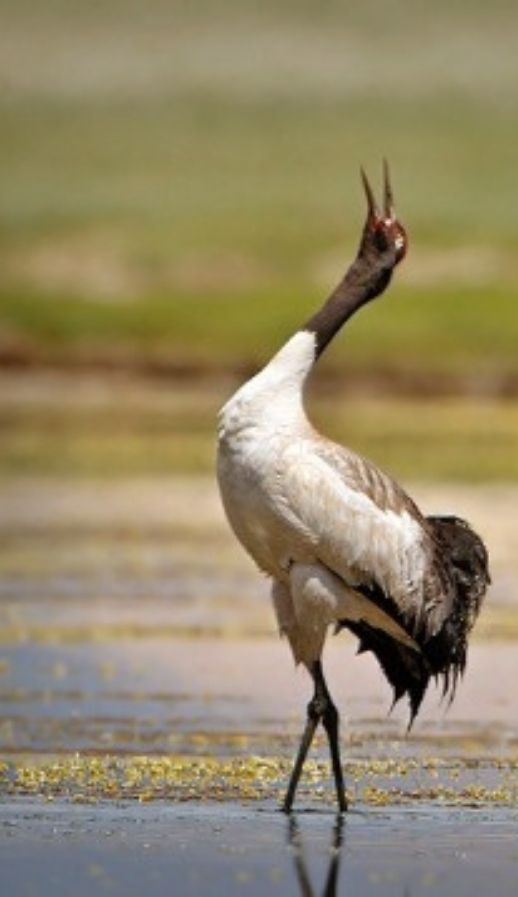
Ladakh
North India, the land of Ladakh, looks as though it was made for birdwatching and photography.

Gir National Park Gujarat
Sometimes it is not just the species spotted but also the amazing moments. Some of our guests had the unique opportunity to witness the mating of Asiatic Lions in the Gir Forest, truly a special moment.

Delhi
Surajpur is an amazing wetland close to the nation’s capital. Apart from being one of the monsoon homes for the Bristled Grassbird, it is also home to another sought-after species: the Bengal Bush Lark.

Rajasthan
One advantage of living near the birding hotspot of Bharatpur is that you can see some amazing birds, like the graceful Sarus Crane, in your backyard during this lockdown


